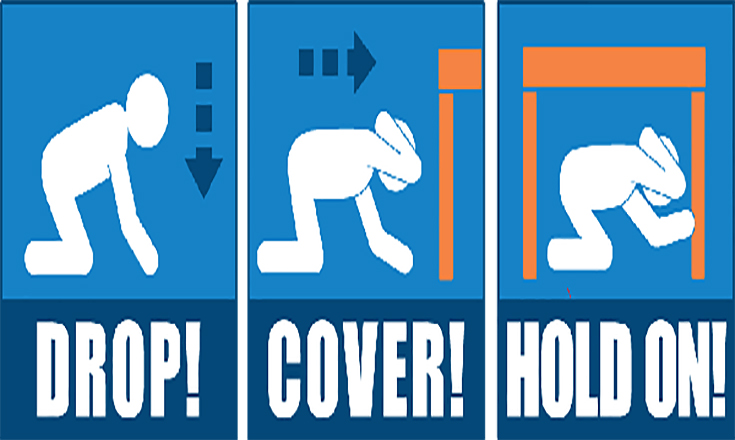Thursday morning’s earthquake drill, managed by the Seattle Central College Campus and Security Office, was part of a nation-wide effort to better prepare people for earthquake emergencies.
In the main cafeteria space of the Broadway Edison building, a 10:17 a.m. verbal alert sounded over the public announcement system. It was unintelligible over the rushing hiss of the water fountain and the echo of the high-ceilinged space. There were confused looks and shrugs, but no one got up from their chairs to take shelter under the tables. No one moved from their place in line in the Admissions Office across the hallway, and no one on the walkway above the cafeteria slowed their pace as they headed to class.
“There was a definite lack of awareness in here,” said Virginia M., a nursing student present in the cafeteria during the drill. “It was really difficult to know what was happening. It sounded like an airport announcement. I’m just glad this wasn’t a real earthquake.”
“Not only are students learning paths to their degrees here, but they are learning valuable life skills that they can carry with them. We are in earthquake territory — we need students to take the drills seriously,” said Sean Chesterfield, Director of Safety and Security for Seattle Central College. “These drills won’t be perfect, but we are constantly taking steps to improve them.”
“Every drill is a test that lets us know which practices work or may need attention,” said Roberto Bonaccorso, Director of Communications for Seattle Central College. Bonaccorso said the staff will be looking at how quickly people react, whether the PA system reaches all major areas and how notifications are received, among other issues.
This summer, Seattle Central College began a poster and business card campaign to get the word into as many hands as possible, no matter the nationality or language background. New students are automatically signed up for alerts using the email they provided during their registration and are heavily encouraged to add a cell phone number so they can also be notified immediately by voice or text.
“There are zones around the campus where announcements can’t be heard,” said Chesterfield. “We are relying on students to stay informed and sign up for the Rave alerts, just as we are relying on the faculty and staff to lead by example when it comes to these drills.”
“Our administration takes the safety of our students and staff very seriously,” said Seattle Central College President Shelia Edwards Lange, “and we will continue to invest time and resources to address issues that arise from drills, weather closures, power outages, and other security situations we experience.”
“Our next big drill is in December, a fire drill,” said Chesterfield. “And we will learn from that drill as well.”
Readiness is just half the battle; awareness without action is useless.
Your friends and family may not be together when a disaster strikes, so it’s important to know which types of disasters could affect your area. Devise a basic plan to contact loved ones and regroup if you get separated. It’s also important to remember to text instead of calling during any disaster, as signal availability will be severely reduced by other worried people trying to do exactly what you’re doing: “I’m okay, I will call as soon as I can.” Establish a meeting place that’s familiar and easy to find, but one located away from impacted areas, tall buildings or large structures, and away from power lines, such as a hill, or a park. Traffic will grind to a halt in the event of an earthquake; several sections of Seattle are built on filler soil which may shake or settle during a significant quake resulting in liquefaction, taking roads, bridges, power lines, cellphone towers, and other key infrastructure down with it.
In ideal conditions, a person would have enough canned, pre-packaged, or “long-life” foods to last each member of the household five days, plus candles or camping lanterns for lighting, approximately 10 gallons of water for cooking and hydration, medications, and pet food. Do you have special dietary needs, and could you maintain that need independently?
Put a bag together with just the basics and keep it somewhere you can get to in a hurry. If you’re on a restrictive budget, you can build your bag slowly; each time you go to the store, add one item to the list for your kit. As you prepare your bag, design the contents around the supplies you require for daily living.
Get in the habit of carrying a full battery charger and the right cables for your phone every day, as well as a water bottle, a pen and a pad of paper, thick black markers, a Swiss Army tool, and a lighter. These are basic tools that could make a huge difference. It’s better to have them and not need them than the opposite. For more information, please visit https://www.shakeout.org/washington/






